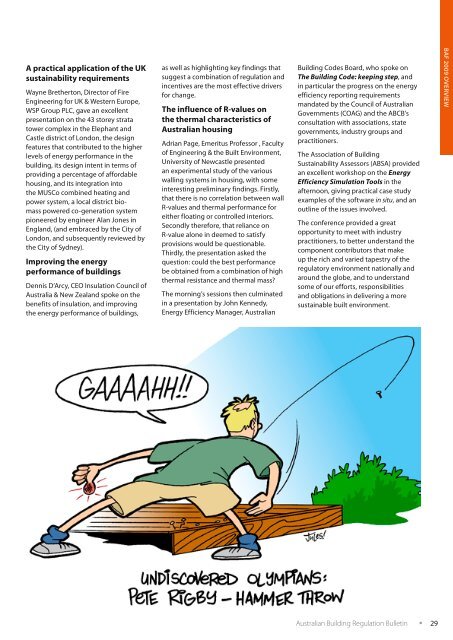BCA 2010 - ABCB - Australian Building Codes Board
BCA 2010 - ABCB - Australian Building Codes Board
BCA 2010 - ABCB - Australian Building Codes Board
You also want an ePaper? Increase the reach of your titles
YUMPU automatically turns print PDFs into web optimized ePapers that Google loves.
A practical application of the UK<br />
sustainability requirements<br />
Wayne Bretherton, Director of Fire<br />
Engineering for UK & Western Europe,<br />
WSP Group PLC, gave an excellent<br />
presentation on the 43 storey strata<br />
tower complex in the Elephant and<br />
Castle district of London, the design<br />
features that contributed to the higher<br />
levels of energy performance in the<br />
building, its design intent in terms of<br />
providing a percentage of affordable<br />
housing, and its integration into<br />
the MUSCo combined heating and<br />
power system, a local district biomass<br />
powered co-generation system<br />
pioneered by engineer Alan Jones in<br />
England, (and embraced by the City of<br />
London, and subsequently reviewed by<br />
the City of Sydney).<br />
Improving the energy<br />
performance of buildings<br />
Dennis D’Arcy, CEO Insulation Council of<br />
Australia & New Zealand spoke on the<br />
benefits of insulation, and improving<br />
the energy performance of buildings,<br />
as well as highlighting key findings that<br />
suggest a combination of regulation and<br />
incentives are the most effective drivers<br />
for change.<br />
The influence of R-values on<br />
the thermal characteristics of<br />
<strong>Australian</strong> housing<br />
Adrian Page, Emeritus Professor , Faculty<br />
of Engineering & the Built Environment,<br />
University of Newcastle presented<br />
an experimental study of the various<br />
walling systems in housing, with some<br />
interesting preliminary findings. Firstly,<br />
that there is no correlation between wall<br />
R-values and thermal performance for<br />
either floating or controlled interiors.<br />
Secondly therefore, that reliance on<br />
R-value alone in deemed to satisfy<br />
provisions would be questionable.<br />
Thirdly, the presentation asked the<br />
question: could the best performance<br />
be obtained from a combination of high<br />
thermal resistance and thermal mass?<br />
The morning’s sessions then culminated<br />
in a presentation by John Kennedy,<br />
Energy Efficiency Manager, <strong>Australian</strong><br />
<strong>Building</strong> <strong>Codes</strong> <strong>Board</strong>, who spoke on<br />
The <strong>Building</strong> Code: keeping step, and<br />
in particular the progress on the energy<br />
efficiency reporting requirements<br />
mandated by the Council of <strong>Australian</strong><br />
Governments (COAG) and the <strong>ABCB</strong>’s<br />
consultation with associations, state<br />
governments, industry groups and<br />
practitioners.<br />
The Association of <strong>Building</strong><br />
Sustainability Assessors (ABSA) provided<br />
an excellent workshop on the Energy<br />
Efficiency Simulation Tools in the<br />
afternoon, giving practical case study<br />
examples of the software in situ, and an<br />
outline of the issues involved.<br />
The conference provided a great<br />
opportunity to meet with industry<br />
practitioners, to better understand the<br />
component contributors that make<br />
up the rich and varied tapestry of the<br />
regulatory environment nationally and<br />
around the globe, and to understand<br />
some of our efforts, responsibilities<br />
and obligations in delivering a more<br />
sustainable built environment.<br />
BAF 2009 OVERVIEW<br />
<strong>Australian</strong> <strong>Building</strong> Regulation Bulletin<br />
• 29

















